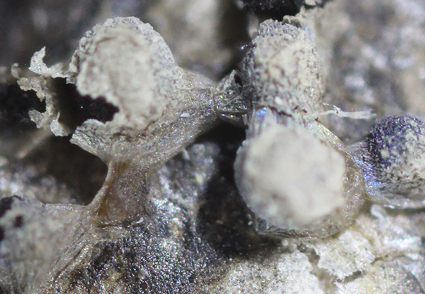Abstract
Diacheopsis is a small genus of myxomycetes with about 18 species reported around the world. Diacheopsis species are recorded in Eurasia, North and South America, Australia and New Zealand. A new species of Diacheopsis from coniferous forest of Asian part of Russia is described and illustrated. The new species occurred on a dead tree of Pinus sylvestris. It differs from all known species of the genus Diacheopsis in the sporocarps being drab grey, beige colours and the spores have warts up to 0.4 µm in total height. By SEM observations the warts are dense, abundant and regularly distributed, well-developed, with coralloid projections on the apex of each wart. Sequences for SSU rDNA of the new Diacheopsis species were generated. Preliminary phylogenetic analyses based on partial 18S rDNA sequences support the establishment of the new species.
References
Borg Dahl, M., Brejnrod, A.D., Unterseher, M., Hoppe, T., Feng, Y., Novozhilov, Y., Sørensen, S.J. & Schnittler, M. (2018) Genetic barcoding of dark-spored myxomycetes (Amoebozoa)—identification, evaluation and application of a sequence similarity threshold for species differentiation in NGS studies. Molecular Ecology Resources 18 (2): 306–318. https://doi.org/10.1111/1755-0998.12725
Fiore-Donno, A.M., Berney, C., Pawlowski, J. & Baldauf, S.L. (2005) Higher-order phylogeny of plasmodial slime molds (Myxogastria) based on elongation factor 1-A and small subunit rRNA gene sequences. Journal of Eukaryotic Microbiology 52 (3): 201–210. https://doi.org/10.1111/j.1550-7408.2005.00032.x
Fiore-Donno, A.M., Meyer, M., Baldauf, S.L. & Pawlowski, J. (2008) Evolution of dark-spored Myxomycetes (slime-molds): molecules versus morphology. Molecular Phylogenetics and Evolution 46 (3): 878–889. https://doi.org/10.1016/j.ympev.2007.12.011
Fiore-Donno, A.M., Kamono, A., Meyer, M., Schnittler, M., Fukui, M. & Cavalier-Smith, T. (2012) 18S rDNA phylogeny of Lamproderma and allied genera (Stemonitales, Myxomycetes, Amoebozoa). PLoS ONE 7 (4): e35359. https://doi.org/10.1371/journal.pone.0035359
Hoppe, T. & Schnittler, M. (2015) Characterization of Myxomycetes in two different soils by TRFLP-analysis of partial 18S rRNA gene sequences. Mycosphere 6: 216–227. https://doi.org/10.5943/mycosphere/6/1/5
Ing, B. (1999) The myxomycetes of Britain and Ireland. An identification handbook. London, 374 pp.
Janik, P., Ronikier, M. & Ronikier, A. (2020) New protocol for successful isolation and amplification of DNA from exiguous fractions of specimens: a tool to overcome the basic obstacle in molecular analyses of myxomycetes. PeerJ 8: e8406. https://doi.org/10.7717/peerj.8406
Katoh, K. & Standley, D.M. (2013) MAFFT multiple sequence alignment software version 7: improvements in performance and usability. Molecular Biology and Evolution 30: 772–780. https://doi.org/10.1093/molbev/mst010
Kumar, S., Stecher, G., Li, M., Knyaz, C. & Tamura, K. (2018) MEGA X: Molecular Evolutionary Genetics Analysis across computing platforms. Molecular Biology and Evolution 35: 1547–1549. https://doi.org/10.1093/molbev/msy096
Lado, C. 2005–2021. An online nomenclatural information system of Eumycetozoa. Real Jardín Botánico, CSIC. Madrid, Spain. Available from: http://www.nomen.eumycetozoa.com (accessed 21 October 2021).
Macbride, T.H. & Martin, G.W. (1934) The Myxomycetes. A descriptive list of the known species with special reference to those occurring in North America. New York, 339 pp.
Martin, G.W. & Alexoupolos, C.J. (1969) The Myxomycetes. Iowa City, 561 pp.
Meylan, C. (1931) Contribucion a la connaissance des myxomycètes du Jura et des Alpes. Bulletin de la Société Vaudoise des Sciences Naturelles 57 (227): 301–307.
Nandipati, S.C.R., Haugli, K., Coucheron, D.H., Haskins, E.F. & Johansen, S.D. (2012) Polyphyletic origin of the genus Physarum (Physarales, Myxomycetes) revealed by nuclear rDNA mini-chromosome analysis and group I intron synapomorphy. BMC Evolutionary Biology 12: e166. https://doi.org/10.1186/1471-2148-12-166
Poulain, M., Meyer, M. & Bozonnet, J. (2011) Les Myxomycètes 1. Guide de détermination. Sévrier, 568 pp.
Shchepin, O.N., Schnittler, M., Erastova, D.A., Prikhodko, I.S., Borg Dahl, M., Azarov, D.V., Chernyaeva, E.N. & Novozhilov, Y.K. (2019) Community of dark-spored myxomycetes in ground litter and soil of taiga forest (Nizhne-Svirskiy Reserve, Russia) revealed by DNA metabarcoding. Fungal Ecology 39: 80–93. https://doi.org/10.1016/j.funeco.2018.11.006
Tamura, K. & Nei, M. (1993) Estimation of the number of nucleotide substitutions in the control region of mitochondrial DNA in humans and chimpanzees. Molecular Biology and Evolution 10: 512–526. https://doi.org/10.1093/oxfordjournals.molbev.a040023


